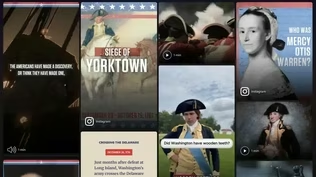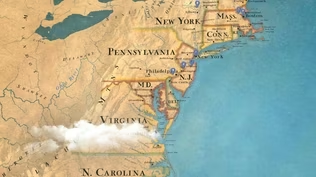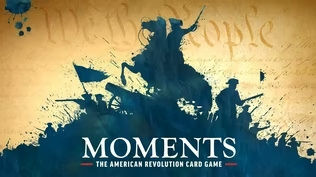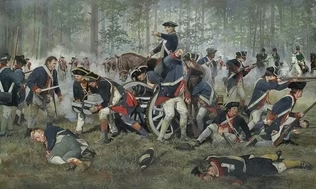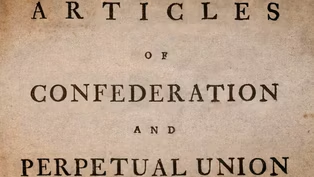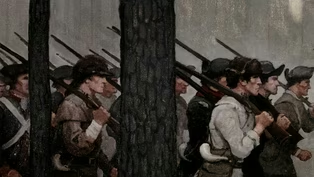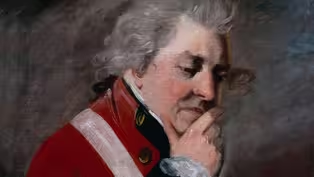
The British Capture Philadelphia & The Battle of Germantown
Clip: Episode 4 | 6m 29sVideo has Closed Captions
The British seize Philadelphia, but Washington plans to retake the city at the Battle of Germantown.
Following the loss of the Battle of the Brandywine, Continental Congress flees Philadelphia and the approaching British army. Washington sends men ahead to defend the city, but they are ambushed at the Paoli Massacre, and Philadelphia is occupied by the British. Washington devises an ambitious plan to engage the British at their headquarters in Germantown.
Problems playing video? | Closed Captioning Feedback
Problems playing video? | Closed Captioning Feedback
Episodes presented in 4K UHD on supported devices. Corporate funding for THE AMERICAN REVOLUTION was provided by Bank of America. Major funding was provided by The Better Angels Society and...

The British Capture Philadelphia & The Battle of Germantown
Clip: Episode 4 | 6m 29sVideo has Closed Captions
Following the loss of the Battle of the Brandywine, Continental Congress flees Philadelphia and the approaching British army. Washington sends men ahead to defend the city, but they are ambushed at the Paoli Massacre, and Philadelphia is occupied by the British. Washington devises an ambitious plan to engage the British at their headquarters in Germantown.
Problems playing video? | Closed Captioning Feedback
How to Watch The American Revolution
The American Revolution is available to stream on pbs.org and the free PBS App, available on iPhone, Apple TV, Android TV, Android smartphones, Amazon Fire TV, Amazon Fire Tablet, Roku, Samsung Smart TV, and Vizio.

MOMENTS: The Revolutionary War Card Game
Use your knowledge of Revolutionary-era moments to build a timeline of real historical events.Providing Support for PBS.org
Learn Moreabout PBS online sponsorshipAt Brandywine, General Howe had repeated the tactics that had won the Battle of Long Island.
Now Washington hoped to repeat his successful surprise attack on Trenton by hitting Howe at Germanton in early October.
Washington's plan was ambitious and complicated.
Success would depend on dividing his 11,000-man force into four separate columns to undertake miles-long marches at night on poorly marked roads so as to arrive simultaneously on the town's northern and western edges at precisely 5 A.M.
on October 4th.
Then, at dawn, they were to storm into town on four different roads.
It would be the first time during the Revolution that Washington dared hurl his army against the main British force.
[Musket fire] John Sullivan's and Anthony Wayne's columns swiftly swept aside British pickets north of the town.
Wayne's men found themselves face-to-face with the British Light Infantry, the same soldiers who had massacred so many of their comrades at Paoli just two weeks earlier.
Voice: Our people pushed on with their bayonets and took ample vengeance for that night's work.
The rage and fury of the soldiers were not to be restrained.
[General Anthony Wayne] Narrator: The Americans continued to push the British back through the town, driving them from one fenced yard to the next.
Voice: Fortune smiled on our arms.
The enemy were broke, dispersed, and flying in all quarters.
We were in possession of their whole encampment.
[Wayne] Narrator: In the face of the advancing Americans, British Lieutenant Colonel Thomas Musgrave ordered half his regiment-- between 100 and 120 soldiers-- to duck inside the largest house in Germanton, the home of Benjamin Chew, the Loyalist ex-chief justice of Pennsylvania.
Its walls were two feet thick.
Musgrave directed his men to block the door and ground-floor windows with furniture.
Downstairs, his men were to bayonet anyone who dared try to enter while others fired into the passing rebels from the upstairs windows.
Atkinson: Washington is advised, "Bypass them.
Go around them.
Isolate them.
Keep the momentum going."
Narrator: But Henry Knox insisted that the house had to be taken right away.
"It would be unmilitary," he said, "to leave a castle in our rear."
Washington agreed.
[Cannons firing] Artillery blew in the front door and damaged statuary in the garden, but bounced harmlessly off the walls.
Continentals from New Jersey repeatedly stormed the house and were cut down on the lawn and front steps.
As the siege at the Chew House went on, the bulk of the American force streamed past, continuing to drive the British back.
A Patriot victory seemed likely.
Voice: About this time came on perhaps the thickest fog known in the memory of man, which, together with the smoke, brought on almost midnight darkness.
It was not possible to distinguish friend from foe at five yards distance.
[Elias Dayton] Narrator: When the men who had penetrated the farthest heard the furious gunfire still coming from the Chew House, they believed the enemy had somehow gotten behind them.
Now it was the Patriots who began to fall back.
General Cornwallis himself led the counterattack.
His troops freed Musgrave's men from the Chew House and drove the Americans back along the roads they'd followed into town.
The British had won...again.
♪ Voice: I rode over the battlefield, and with surprise and admiration approached the house, which the brave Colonel Musgrave had defended.
During the battle, some thirty defenders were killed and wounded.
I counted seventy-five dead Americans.
The rooms of the house were riddled by cannonball and looked like a slaughterhouse because of the blood splattered around.
There, the entire English army was saved.
Johann Ewald.
Atkinson: For the Americans, what had been a sure victory-- it looked like they were going to drive the British back into Philadelphia--becomes a fairly significant defeat.
Washington gets away again, but there are hundreds of casualties.
The British capture quite a few Americans.
And what had been a glorious morning turns into a very grim evening.
Narrator: Reporting to Congress, Washington tried to put the best face he could on his humiliating defeat.
Voice: Upon the whole, it may be said the day was rather unfortunate than injurious.
We sustained no material loss of men and brought off all our artillery, except one piece.
The enemy are nothing the better by the event.
And our troops, who are not in the least dispirited by it, have gained what all young troops gain by being in actions.
[Washington] He is very good at, I think, the key tactic for an insurrectionary force, which is living to fight another day, and successfully plays a long game of just not being crushed.
Ellis: Washington's not a great field commander, but he's resilient, and he understands the kind of war he's fighting.
At some point, he reaches the insight-- and it's a basic insight-- he doesn't have to win.
The British have to win.
He only has not to lose.
Video has Closed Captions
Clip: Ep4 | 2m 14s | The Articles were weak by design and left Congress unable to pay soldiers in the Continental Army. (2m 14s)
Video has Closed Captions
Clip: Ep4 | 6m 18s | General Horatio Gates' force clashes with the British, beginning the Battle of Saratoga. (6m 18s)
The Haudenosaunee Choose Sides in the American Revolution
Video has Closed Captions
Clip: Ep4 | 8m 7s | The Six Nations of the Haudenosaunee choose opposing sides at the Battle of Oriskany. (8m 7s)
Video has Closed Captions
Clip: Ep4 | 1m 9s | Artistic renderings of the Revolution often include the flag, but little is known about its origins. (1m 9s)
Patriot Victory at the Battle of Saratoga
Video has Closed Captions
Clip: Ep4 | 8m 59s | After days of fighting at Saratoga, Benedict Arnold and Horatio Gates secure a Patriot victory. (8m 59s)
Preview: Conquer by a Drawn Game
Video has Closed Captions
Preview: Ep4 | 30s | Philadelphia falls, but the American victory at Saratoga allows France to enter the war. (30s)
The Real People Who Fought the American Revolution
Video has Closed Captions
Clip: Ep4 | 4m 31s | Washington uses bonuses and drafts to encourage Americans to join the Continental Army. (4m 31s)
Religion & the Revolutionaries
Video has Closed Captions
Clip: Ep4 | 2m 5s | Most revolutionaries were Protestants, but there were also Catholics, Jews, and Muslims. (2m 5s)
Saratoga: A Psychological Turning Point
Video has Closed Captions
Clip: Ep4 | 33s | Historian Stephen Conway on the psychological impact of Saratoga on the British. (33s)
Turning the Tide in New Jersey
Video has Closed Captions
Clip: Ep4 | 59s | With Washington commanding less than 3,000, the winter of 1777 became a fight over supplies. (59s)
Providing Support for PBS.org
Learn Moreabout PBS online sponsorshipSupport for PBS provided by:
Episodes presented in 4K UHD on supported devices. Corporate funding for THE AMERICAN REVOLUTION was provided by Bank of America. Major funding was provided by The Better Angels Society and...

